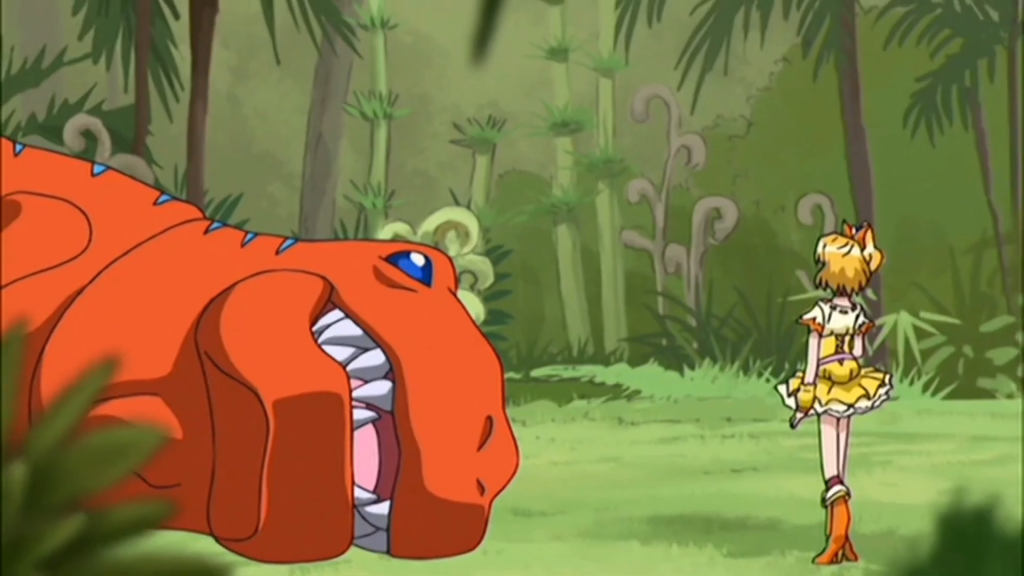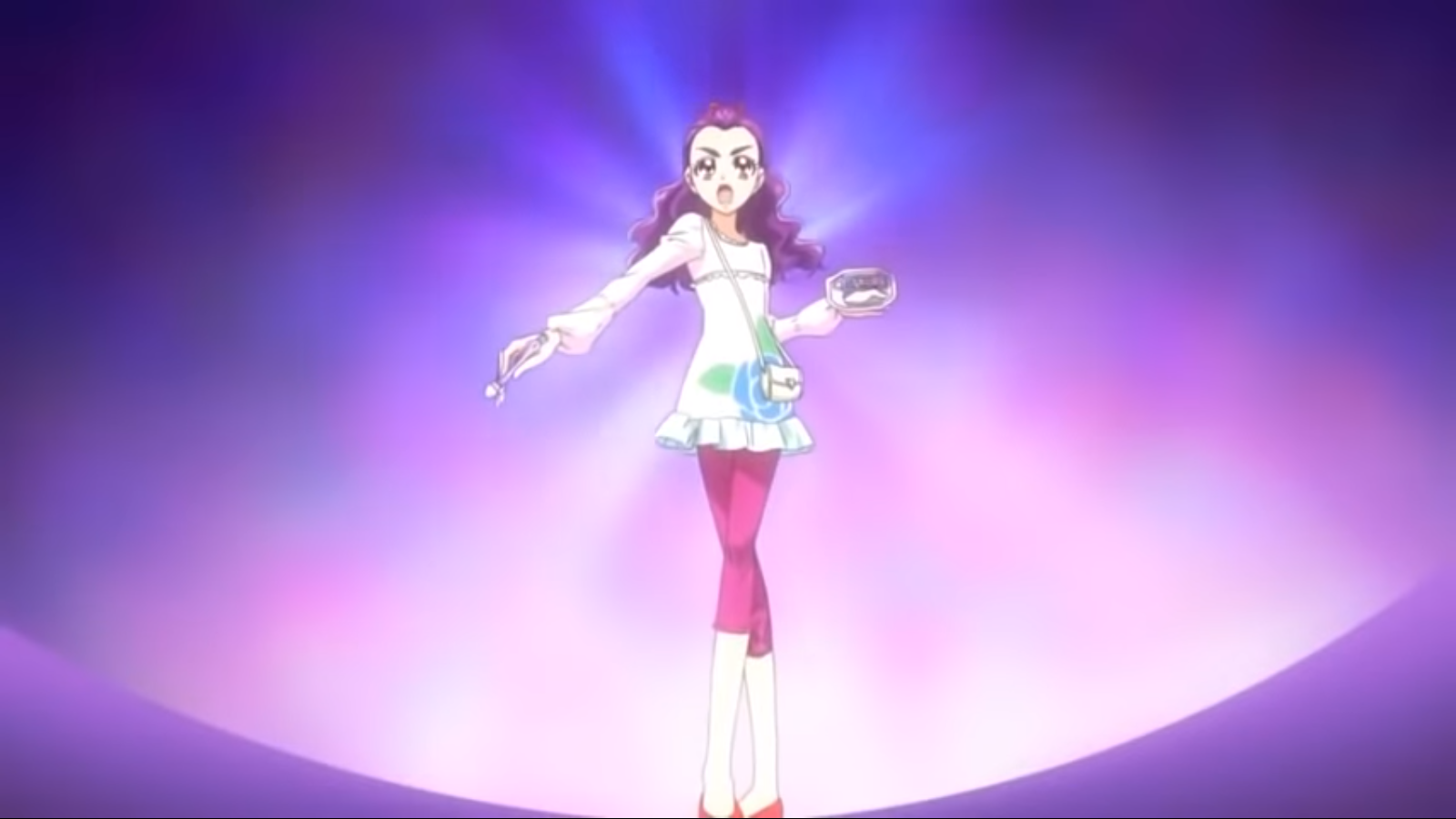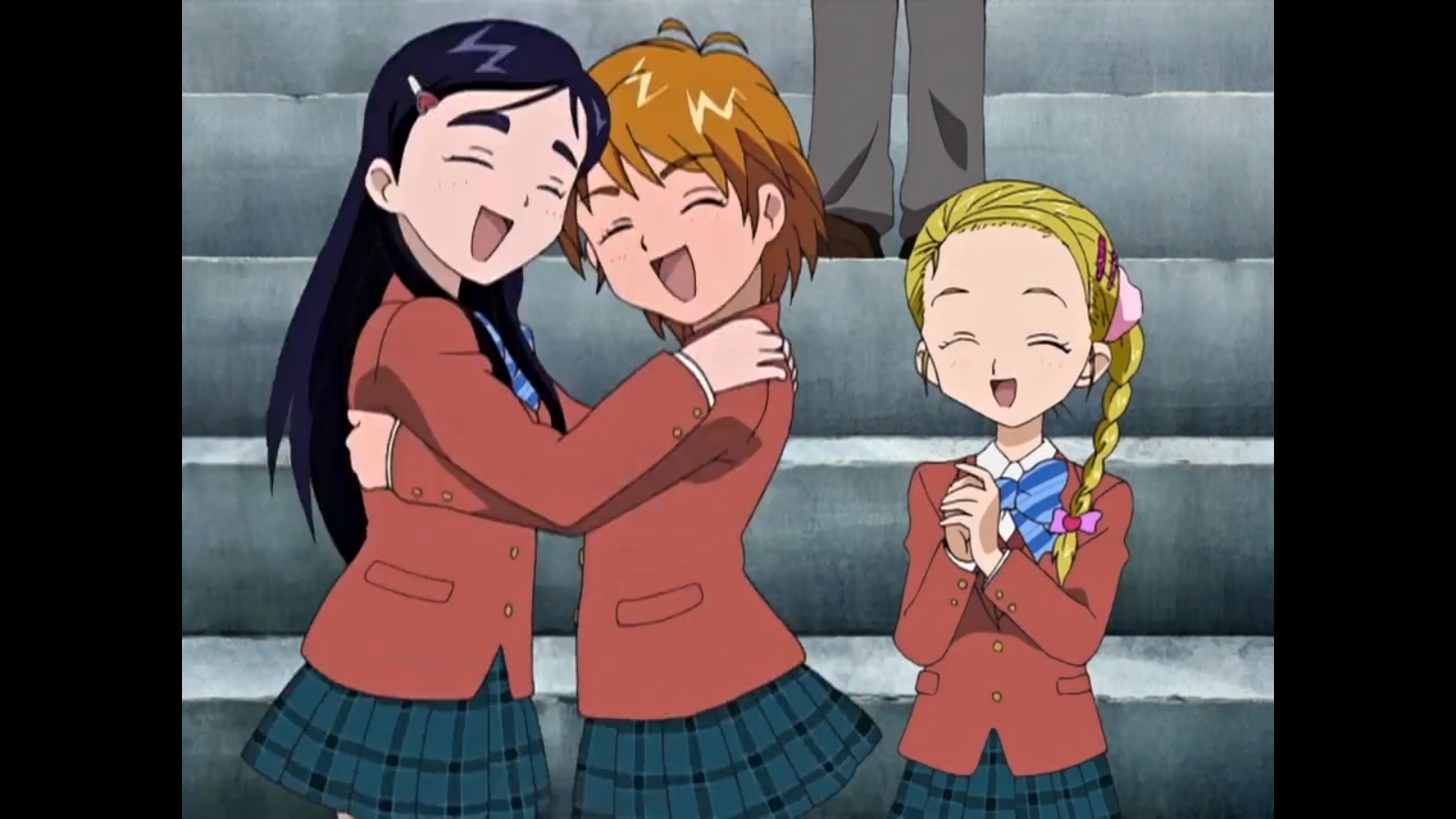You know, as long as I’ve been doing this I’m surprised that this is the first Precure series I’m looking at. For those of you who are unfamiliar, Precure or Pretty Cure is a long running magical girl franchise from Toei animation. It all started with Futari wa Pretty Cure and the most recent installment is Happiness Charge Precure, which is currently ongoing. Most of the series within the frranchise don’t have anything to do with one another aside from a similar aesthetic and Doki Doki Precure is the tenth series within the franchise. The writing for this one was handled by Yamaguchi Ryota, who anime fans may recognise as the writer behind the Escaflowne anime. So, how does this one hold up?
Story:
Our story opens with a Precure, we later learn that her name is Cure Sword, fighting monsters in a desolate landscape. Skip ahead to a group of students on a field trip and student council President Aida Mana’s efforts to keep order. Their trip is interrupted when a teal-haired boy creates a monster from a person’s heart which attacks the area. Mana is told that she can transform, which she does, enabling her to save the day. She finds out that the monsters are called the Selfish and they’re attempting to gather dark energy to unseal their ruler, King Selfish, who was trapped in stone during the Selfish’s invasion of the Trump Kingdom.
It’s a pretty standard magical girl plot. So, the question becomes, how well is it executed? Well, let’s start with the positive aspects. The way the Selfish turn people into monsters is interesting and I do like that they always use the kinds of selfish thoughts that we all have at times. The antagonists in general are well handled, not being portrayed as outright evil but more as inconsiderate jerks which both makes for an interesting conflict and opens up the possibility of redemption, which is definitely taken full advantage of. The story also has some really good twists which are hinted at but are still difficult to anticipate. There are some excellent humourous moments as well and quite a few superb heartwarming moments. The series also manages some crowning moments of awesome.
So, with all that going for it, what are the weaknesses? The truth is that there’s only one major flaw to the storytelling. There are five episodes towards the end of the series (34-38) that have no bearing on the plot and are just kind of filler. Now, that probably doesn’t sound that bad. But these episodes are just annoying. The character interactions in them are weak. They lack the good humour of the rest of the series and four of the five put the focus on the worst character in the series, but we’ll get to her later.
Characters:
Most of the characters in this series are really lovable and just generally amazing. Mana, Rikka, Alice, Makoto and Regina are all great characters who interact perfectly with one another and they’re a lot of fun to watch. Most of the side characters are quite enjoyable as well, especially Sebastian. (I wouldn’t mind seeing more of that charming man and his epic mustache.) There are really two weaknesses here. The first is Aguri. She is a severely under-developed character. Whereas the other girls act and feel like actual girls, Aguri is just kind of two-dimensional. Her main defining characteristics are that she scolds people and likes sweets. Her scolding can also get a little grating at times. That being said, Aguri is not that bad. The series has Ai for that.
Ai is the exceedingly obnoxious character I mentioned earlier who gets the focus for four of those five bad episodes. Most of the time Ai stays, thankfully, in the background, but there are moments when she comes into the forefront and she spends all her time there crying, throwing tantrums or just being generally the most obnoxious thing since Navi. Now, some of you are probably thinking “she’s a baby character, aren’t you being harsh?” No, no I’m not. There are two main reasons. One, she frequently doesn’t even act like a real baby so you can’t say “well, it’s a realistic portrayal of an infant.” It’s like she was deliberately written just to be annoying. Two, she is a pointless character. I’m not even kidding. The explanation they give to justify her existence in the story is really flimsy. You could literally replace her with a black Labrador and the story would still be just as cohesive, if not more so since most of the stupid and pointless episodes would be gone.
Art:
The art is done in kind of a cutesy style, which does work perfectly for the aesthetic of the series. I do appreciate that the girls look very different when they transform into Precures, which makes it realistic that they wouldn’t have their identities discovered. Unlike some magical girl series where they’re just wearing different outfits. I love Sailor Moon, but it’s a prime example of that as a problem. The monster designs are strange. There’s a mailbox goat, a stoplight monster and many others that are just weird. That being said, the designs are creative and I rather like most of them. Sure, a lot of them are silly but that works for the franchise.
The usual transformation and special attack stock footage are present and they’re just as lazy as they usually are. In all fairness, however, they aren’t bad sequences in the slightest. The special attacks are dynamic and the transformations, except possibly Aguri’s, do look good. I will give the series credit for its action sequences, a good percentage of the special moves involve actual weapons instead of wands, microphones, castanets and the like. The action sequences also involve actual fighting moves with punches and kicks. The combination of that with the stock attacks does make the action scenes a lot more dynamic and interesting.
Most of the action sequences are really good, but there are some that move up into excellent. I don’t want to give anything major away, but I will give one example. There’s a particular scene where an enemy breaks Alice’s shield in half. In a true crowning moment of awesomeness, she actually grabs the pieces and uses them like swords. It is just as cool as it sounds and definitely ranks among the best action sequences I’ve ever seen in a magical girl anime.
Sound:
Doki Doki Precure has some really talented actors. Mana is voiced by Nabatame Hitomi (Gokujou Seitokai’s Kanade.) The other main characters, Rikka, Makoto, Alice and Regina, are voiced by Kotobuki Minako (K-on’s Mugi), Miyamoto Kanako (who I have not heard in any other major roles), Fuchigami Mai (Girls Und Panzer’s Miho), and Watanabe Kumiko (Sailor Moon’s JunJun.) They all give good performances. The music is really good. Especially Makoto’s songs.
That being said, it’s not all positive. The faeries all have verbal ticks that can get kind of annoying. Ai doesn’t get much dialogue aside from her usual shrill screaming, but when she does it’s pretty grating. The unfortunate task of voicing her went to Imai Yuka, who is not a bad actor by any means. You can even tell that from this series since she also voices Princess Ange, who is not obnoxious to listen to.
Ho-Yay:
You know, I’ve seen a lot of anime with shoujo-ai subtext, subtext so blatant it might as well be text and text. This is the first time I’ve seen a series that has a shoujo-ai poly-amorous five-some. Mana, Rikka, Alica, Makoto and Regina all seem to be into one another, all of them but Regina even come out and say they love all the others. Regina only ever says that she loves Mana, but there are some really homo-erotic scenes where the other three reach her heart, particularly Makoto and Alice. You also get some lovely scenes wherein Rikka is said to be an ideal wife for Mana, which Mana agrees with, and wherein Makoto and Mana are likened to a newlywed couple. Some of you are probably wondering which pairing makes the most sense when it comes to those five? The answer really is a poly-amorous grouping. All five of these girls are incredibly homo-erotic with one another, and I respect their decision.
That isn’t even the extent of the les-yay in this series. Even Aguri gets some homo-erotic scenes with one of her classmates, Eru. It’s also heavily implied that Makoto had a crush on Princess Ange before the Trump Kingdom fell and, unlike some magical girl anime, there are no gratuitous male love interests to try and disguise it. The Ho-yay is at a solid 7/10 for a huge number of really cute scenes.
Final Thoughts:
This anime is cutesy, overly optimistic, kind of cheesy and I absolutely love it. It’s a highly enjoyable series with some great characters who have awesome interactions, surprisingly epic scenes, and some amazing tender scenes. It’s just a delight to watch. That being said, it does suffer from Ai, five bad episodes, Ai, a reliance on stock footage and, of course, Ai. Fortunately, those aren’t major problems since Ai is mostly kept to the background, and the bad episodes can be easily skipped without losing anything of value. I do highly recommend this to anyone who enjoys the magical girl aesthetic. Unless you’re one of those people who thinks that the worst trope commonly used in magical girl anime is the shoujo ai subtext (yes, those people do exist. No, I don’t understand it either) because there is a massive amount of it in this series. For myself, I give it a 9/10. Next week I’ll take a look at Sword Art Online now if you’ll excuse me I’m going to look for plushies of Mana, Rikka, Alice, Makoto and Regina.













